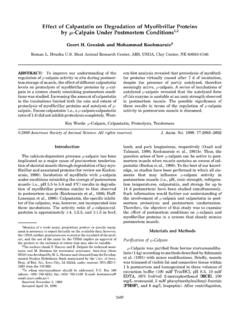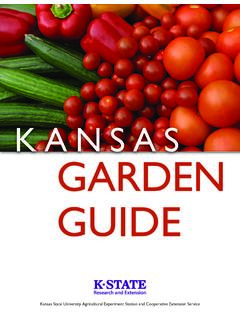Transcription of Commercial Storage : USDA ARS
1 United States Department of Agriculture agricultural research Service The Commercial Storage Agriculture Handbook Number 66 of Fruits, Vegetables, and Revised February 2016. florist and nursery stocks United States Department of Agriculture agricultural research Service The Commercial Storage Agriculture Handbook Number 66. of Fruits, Vegetables, and florist and nursery stocks Edited by Kenneth C. Gross, Chien Yi Wang, and Mikal Saltveit _____. Gross and Wang are formerly with the Food Quality Laboratory, Beltsville agricultural research Center, USDA, agricultural research Service, Beltsville, MD.
2 They are now retired. Saltveit is with the Department of Plant Sciences, University of California, Davis, CA. Abstract The information contained in AH-66 has been assembled from material prepared by nearly a Gross, Kenneth C., Chien Yi Wang, and Mikal hundred authors from around the world. All of the Saltveit, eds. 2016. The Commercial Storage of information contained herein was peer reviewed Fruits, Vegetables, and florist and nursery stocks . and edited for scientific content. Every effort was Agriculture Handbook 66, Department made to provide the most accurate and current of Agriculture, agricultural research Service, information available.
3 Washington, DC. The contributors' professional affiliations Agriculture Handbook 66 (AH-66) represents and addresses were up-to-date at the time of a complete revision and major expansion of submission of their chapters, and the editors the 1986 edition. It has been reorganized and made all reasonable efforts to update any changes now includes 17 Chapters and 138 Commodity received during the review and publishing process. Summaries written by nearly a hundred experts However, due to the large number of contributors in plant science and postharvest technology.
4 And countries represented, it is not inconceivable This version, like the previous editions of AH- that some of the contributors may have changed 66 in 1954, 1968, 1977, and 1986, presents organizations in the interim and thus are no summaries of current Storage requirements longer at the addresses given in this handbook. In of fresh fruits, vegetables, cut flowers, and cases where the editors received specific address other horticultural crops. However, this highly changes or death notices, all such updates are expanded version also includes information on reflected in this volume.
5 Quality characteristics, maturity indices, grading, packaging, precooling, retail display, chilling Mention of trade names or Commercial products sensitivity, ethylene production and sensitivity, in this report is solely for the purpose of pro- respiration rates, physiological disorders, viding specific information and does not imply postharvest pathology, quarantine issues, and recommendation or endorsement by the suitability as fresh-cut product. A large number Department of Agriculture. of fruits and vegetables were added, as well as sections on food safety, nutritional quality, This publication reports experimental results texture, and fresh-cut produce.
6 The purpose of and other information involving pesticides. It storing plant material is to lengthen the time it does not contain recommendations for their use can be consumed or utilized. In doing so, it is nor does it imply that uses discussed here have critical to provide an environment that minimizes been registered. All uses of pesticides must be deterioration, maintains microbial safety, and registered by appropriate State and/or Federal retains other quality attributes. AH-66 provides agencies before they can be recommended.
7 Guidelines and other important information for storing and handling horticultural commodities While supplies last, printed copies of this to accomplish this. publication may be obtained at no cost from the USDA-ARS Food Quality Laboratory, Building Keywords: carbon dioxide, chilling injury, 002, Room 117, 10300 Baltimore Avenue, cold Storage , controlled atmosphere Storage , Beltsville, MD 20705-2350. cut flowers, ethylene, flavor, food safety, fresh-cut, fresh produce, fruit softening, heat Copies of this publication may be purchased load, 1-methylcyclopropene, microbial safety, in various formats (microfiche, photocopy, minimally processed, modified-atmosphere CD, and print on demand) from the National packaging, potted plants, nutritional quality, nuts, Technical Information Service, 5285 Port Royal orchids, packaging film, perishable, postharvest Road, Springfield, VA 22161, (800)
8 553-6847, biology, precooling, respiration, sensory evaluation, shelf-life, texture. ii This publication in its entirety is freely accessible on the Internet at indexpubs. ARS Mission The agricultural research Service conducts research to develop and transfer solutions to agricultural problems of high national priority and provides information access and dissemi- nation to ensure high-quality, safe food and other agricultural products; assess the nutritional needs of Americans; sustain a competitive agricultural economy; enhance the natural resource base and the environment; and provide economic opportunities for rural citizens, communities, and society as a whole.
9 The Department of Agriculture (USDA). prohibits discrimination in all its programs and activities on the basis of race, color, national origin, age, disability, and where applicable, sex, marital status, familial status, parental status, religion, sexual orientation, genetic information, political beliefs, reprisal, or because all or part of an individual's income is derived from any public assistance program. (Not all prohibited bases apply to all programs.) Persons with disabilities who require alternative means for communication of program information (Braille, large print, audiotape, etc.)
10 Should contact USDA's TARGET Center at (202) 720-2600 (voice and TDD). To file a complaint of discrimination, write to USDA, Director, Office of Civil Rights, 1400 Independence Avenue, , Washington, 20250-9410, or call (800) 795-3272 (voice). or (202) 720-6382 (TDD). USDA is an equal opportunity provider and employer. Revised February 2016. iii Acknowledgments The editors gratefully acknowledge the generous assistance and helpful contributions of the following reviewers: Douglas Adams, Leo Gene Albrigo, Douglas Archbold, Reginaldo Baez- Sanudo, Elizabeth Baldwin, Randolph Beaudry, John Beaulieu, Shimshon Ben-Yehoshua, Paul Blankenship, Sylvia Blankenship, William Bramlage, Jeffery Brecht, Kathleen Brown, Jem Burdon, Arthur Cameron, Marita Cantwell, William Conway, Stephen Drake, Bob Elliott, Timothy Facteau, Ian Ferguson, Louise Ferguson, Charles Forney, Maria Gil-Munoz, Gustavo Gonzalez-Aguilar, Jim Gorny, Robert Griesbach, Laurie Houck, Don Huber, Benjamin Juven.
















